If you’ve ever picked up your electric guitar only to hear a frustrating buzz or find a note that just dies instead of ringing out, you’re not alone. Fixing common problems like buzzing and dead frets is essential for keeping your guitar playing smoothly and sounding great. These issues can turn an otherwise excellent build into a frustrating experience, especially for players working with DIY electric guitar kits. In this guide, we’ll break down what causes these problems, how to identify them, and what you can do to fix and prevent them.

Understanding Fret Buzz: Identifying the Root Cause
Fret buzz happens when a string vibrates against a fret that it shouldn’t be touching during normal play. It’s often more than just annoying — it can signal underlying issues with your setup or construction that need correction.
What Causes Fret Buzz?
Several factors can lead to fret buzz, including:
- Improper string action: If the strings are too low, even the lightest touch can cause them to rattle against the frets.
- Loose hardware: Tuners, bridge components, or even neck screws can introduce sympathetic vibrations that sound like buzzing.
- Uneven frets: A single high fret can throw off the playability across the whole neck.
- Humidity and temperature changes: Wood expands and contracts with environmental shifts, often leading to neck relief changes or fret sprout.
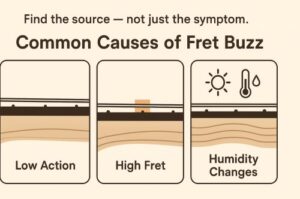
For a deep dive into how wood reacts to its environment, check out Effects Of Different Wood Types On Electric Guitar Tone.
** Here’s a little transparency: Our website contains affiliate links. This means if you click and make a purchase, we may receive a small commission. Don’t worry, there’s no extra cost to you. It’s a simple way you can support our mission to bring you quality content. **
As an Amazon Associate, I earn from qualifying purchases.
Detecting Troubled Frets: A Step-by-Step Guide
Finding exactly which fret is causing a problem can be tricky without a system. Here’s how to approach it:
Step 1: Listen Carefully
Play every fret up and down the neck on each string. Pay attention to buzzes that are isolated to specific frets.
Step 2: Use a Straightedge
Lay a notched straightedge across the fretboard to check for neck relief and uneven frets.
Step 3: Try a Rocker Tool
A fret rocker — small straightedge that spans three frets at a time—can pinpoint high frets. If it rocks back and forth, the middle fret is too high.
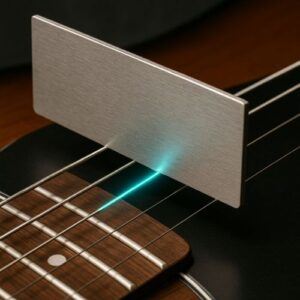
Step 4: Measure Relief
Use a feeler gauge to measure neck relief at the 7th or 8th fret while fretting the 1st and 17th. Too little relief can contribute to buzz.
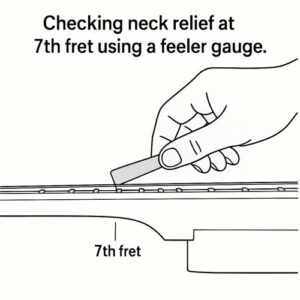
Need to understand how pickup height interacts with these issues? Visit Adjusting Pickup Height For Optimal Sound On Your Guitar.
The Mystery of Dead Frets: Causes and Challenges
Unlike buzzing frets that still produce sound (albeit a bad one), dead frets make little or no sound at all when played. They often sound dull, muted, or completely silent, and can appear suddenly.

Common Causes of Dead Frets
- Worn or loose fret wire: Over time, frets can wear down unevenly or even lift from the board.
- Neck warping or twisting: Structural neck issues can cause dead zones on the fretboard.
- Improper fret leveling: If frets aren’t leveled properly during a kit build, one high or low fret can choke out the note.
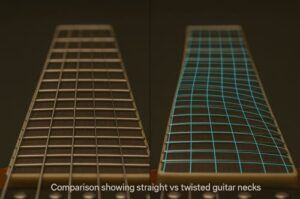
Ignoring a dead fret means you’re stuck with limited tonal range and compromised performance. If you’re building your own instrument, make sure to revisit Step-by-Step Guide To Building Your First Electric Guitar Kit to double-check your leveling process.
Solutions and Techniques to Resolve Fret Issues
Now that you’ve identified the problem, let’s get to the fix.
Adjust the Truss Rod
Sometimes buzz results from neck curvature issues. Carefully adjust the truss rod to add or reduce relief—but make small turns and check often.

Learn more about proper neck setup in Setting Up The Bridge And Neck On Your Electric Guitar Kit.
Check Bridge Saddle Height
Raise the saddles slightly for strings that are buzzing near the bridge end of the fretboard.

Level and Dress Frets
This involves filing the tops of the frets so they’re even, then re-crowning and polishing them. It’s tedious but effective.

Consider Professional Help
If you’ve tried basic adjustments and still face issues, it might be time to take your guitar to a luthier — especially in the case of twisted necks or extensive dead frets.
Need tools for these jobs? Browse Essential Tools Every Electric Guitar Kit Builder Should Have.
Proactive Measures: Preventing Buzzing and Dead Frets
A little maintenance goes a long way in preventing fret issues.
Control Humidity
Keep your guitar in a space with consistent humidity — ideally between 45–55%. Use a room humidifier or in-case humidifier when necessary.
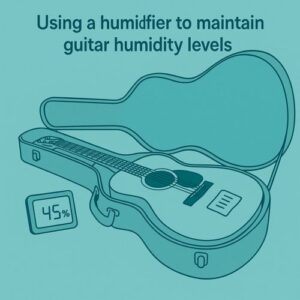
Regular Setup Checks
Inspect your guitar every few months for changes in action, neck relief, and fret condition.

Clean and Condition Your Fretboard
Grime buildup and dry wood can both cause problems. Use fretboard oil (only on unfinished rosewood or ebony) and wipe down your frets often.
When In Doubt, Get a Pro Setup
An annual professional setup can extend the life of your guitar and prevent more serious problems.

Also see Troubleshooting Common Issues During Electric Guitar Kit Assembly for more ways to avoid early-stage mistakes.
Final Thoughts…
Buzzing and dead frets can derail your tone, your practice sessions, and even your passion for playing — but they’re not the end of the world. With the right diagnostic tools and a little knowledge, you can fix most issues yourself or know when to call in a pro.
If you’re building your own electric guitar or modifying a kit, understanding how to identify and fix fret issues is essential. From adjusting the truss rod to leveling frets, the key is to approach the problem methodically and act early before a minor issue becomes a major one.

Explore More Helpful Guitar Kit Articles:
- Using Tone Pots And Capacitors To Sculpt Your Sound
- How Pickup Position Affects Electric Guitar Tone In Kits
- Customizing Your Electric Guitar Kit With Unique Fretboard Inlays
There are 100’s of ways you can build a business around your passion for guitar building.
Check it out…
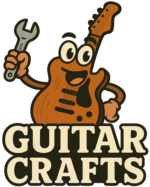



This guide is truly a game-changer for anyone wrestling with frustrating fret buzz or those sudden dead notes. I really appreciate how you break down the potential causes—whether it’s improper string action, uneven frets, humidly-induced neck relief shifts, or worn and loose fret wire—and then walk through the diagnostics with tools like a notched straightedge, fret rocker, and feeler gauges. That step-by-step approach gives both clarity and confidence for tackling the issue.
What stands out most is the emphasis on prevention, not just repair. Regular humidity control, fretboard cleaning, and periodic setup checks can really save a lot of headaches down the line. It’s encouragement toward proactive guitar care, not just reactive fixes.
For anyone who’s experienced a sudden dead fret—often it’s worn or sunk fret wire, or subtle neck warping that chokes the note. Having a methodical troubleshooting mindset—play-testing frets, checking straightness, using a rocker—can keep what might feel like a deal-breaker manageable, or at least solvable with care or professional help.
Would love to know: which step do builders often overlook—something that feels minor but actually has major impact? Let me know if you’d like a more casual or technical version!
Thank you so much! I’m glad the guide helped make fret buzz and dead notes feel more manageable.
Those issues can be really frustrating for builders, especially at first.
One step that’s often overlooked is checking relief after string changes. It seems small, but even a subtle shift in neck relief can cause fret buzz or dead notes that seem inexplicable. Another easy-to-miss detail is spotting uneven frets with a rocker—even a tiny high spot can throw off an entire section of the fretboard. Paying attention to these “minor” things early can save a lot of trial-and-error and keep the guitar playing smoothly.
It’s those little preventative steps that really make a difference between a frustrating setup and a guitar that feels effortless to play.
Thanks again,
~Wayne
This is a fantastic, detailed guide! I love how you break down both buzzing and dead frets with clear steps and practical tips. The step-by-step approach for detecting trouble frets, especially using a straightedge or fret rocker, is super helpful for DIY builders like me. I also appreciate the proactive advice about humidity control and regular setup checks—small maintenance tweaks can save a lot of headaches down the line.
Out of curiosity, in your experience, which fret issue tends to show up most often in beginner DIY kits: buzzing from uneven frets or dead frets from neck warping?
Thanks so much—I’m glad you found the guide helpful! You hit on a really important point: a lot of fret issues are preventable with just a bit of ongoing care like humidity control and regular checkups.
In my experience, buzzing from uneven frets tends to be the more common issue in beginner DIY kits. That’s usually because the frets aren’t perfectly leveled out of the box, and a tiny high spot can cause noticeable buzzing. Dead frets from neck warping do happen, but they’re less frequent right away—they usually show up later if the guitar hasn’t been stored properly or the truss rod wasn’t adjusted after seasonal changes.
So, buzzing is often the first thing to tackle, but keeping an eye on neck relief over time will prevent those dead frets from sneaking in down the road.
Thanks again,
~Wayne